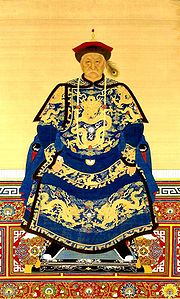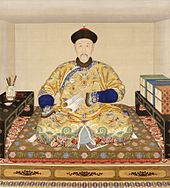- Deliberative Council of Princes and Ministers
-
The Deliberative Council of Princes and Ministers (simplified Chinese: 议政王大臣; traditional Chinese: 議政王大臣; pinyin: yìzhèng wáng dàchén), also known as the Council of Princes and High Officials or simply as the Deliberative Council (simplified Chinese: 议政处; traditional Chinese: 議政處; pinyin: yìzhèng chù), was an advisory body for the Emperors of the early Qing Dynasty. Derived from informal deliberative groups created by Nurhaci in the 1610s and early 1620s, the Council was formally established by Hung Taiji in 1626 and expanded in 1637. Staffed mainly by Manchu dignitaries, this aristocratic institution served as the chief source of advice on military matters for Hung Taiji and the Shunzhi (r. 1644-1661) and Kangxi (r. 1662-1722) Emperors.[1][2][3][4] It was particularly powerful during the regencies of Dorgon (1643-1650) and Oboi (1661-1669), who used it to enhance their personal influence.[5]
After serving as the most influential policymaking body of the dynasty for more than a century, the Deliberative Council was displaced and then made obsolete by the more ethnically mixed Grand Council, which the Yongzheng Emperor (r. 1723-1735) created in the late 1720s to circumvent the influence of the Deliberative princes and ministers. It was formally abolished in 1792.
Contents
Origins and formal establishment
The Council originated among informal institutions created by Nurhaci (1559-1626) to promote collegial rule among his sons. Historian Robert Oxnam has called the origin of the Council "a complicated and often confusing process."[6] In 1601, Nurhaci had organized Manchu society into four "Banners" that were doubled in number in 1615 to become the Eight Banners.[7] In 1622, he gave eight of his sons (who were called "princes," or beile) control over one banner each[7] and ordered them to meet to deliberate major policies, especially military matters.[8][9] Nurhaci's eight sons were known collectively as the "princes who deliberate on government" (yizheng wang).[8]
Another precursor to the Council was a group of "five high officials" and "ten judges" (jarguci), all Manchus, that Nurhaci put in charge of administrative and judicial tasks in 1615 or 1616.[10] Robert Oxnam claims that this group was then referred to as "high officials who deliberate on government" (yizheng dachen).[8] and assisted the princes in discussing policy.[11] Frank Michael, however, claims that they were mere "technical advisors,"[12] a point of view supported by Silas Wu.[13] In 1623, "eight high officials" were also made deliberative officials, but their functions were chiefly censorial.[13][14]
Nurhaci was succeeded by his son Hung Taiji (r. 1626-1643), who, instead of following his father's wish of collegial rule, became a strong ruler who laid the institutional foundation of the Qing Dynasty. In 1627,[15] he placed the Eight Banners under the command of eight "high officials" (Ma.: gusai ejen; Ch.: dachen), who were also told to assist the princes in policy deliberations.[11][16] Silas Wu identifies this reform as the bona fide origin of the Deliberative Council,[13] which then became his main policymaking structure.[11] In 1637, one year after he had declared himself Emperor of the Qing Dynasty, Hung Taiji officially excluded imperial princes from the Council.[13][11] Instead, the Council was manned by eight lieutenant-generals (later called dutong in Chinese) with two deputies (fu dutong) each, who were put in charge of managing the Eight Manchu Banners.[11][17] By limiting Council membership to Manchu military leaders from outside the imperial clan, Hung Taiji enhanced his personal power at the expense of the other princes.[5]
Central role in the early Qing
 Oboi used the Deliberative Council as his main policymaking tool from 1661 to 1669 during his co-regency for the Kangxi Emperor.
Oboi used the Deliberative Council as his main policymaking tool from 1661 to 1669 during his co-regency for the Kangxi Emperor.
When Hung Taiji died in 1643, he was replaced by the young Shunzhi Emperor and two co-regents: Dorgon and Jirgalang. In 1644, under their leadership, the Qing defeated the weakened Ming Dynasty and moved its capital to Beijing. The Deliberative Council of Ministers was Dorgon's main policymaking body during his regency.[18] Soon after moving to Beijing, he gave the Council control over both military and civil affairs, and expanded its membership to all lieutenant-generals and deputy lieutenant-generals in the Manchu and Mongol Banners, as well as to all Mongols and Manchus who held posts of Grand Secretary or Board president.[18] Far from limiting Dorgon's power, the Council served as his tool to denounce and arraign other princes who challenged his authority.[19]
After Dorgon fell and was replaced by his co-regent Jirgalang, the latter made a number of special appointments to the Council to foster loyalty among the Manchu elite.[20] Between 1651 and 1653, he added thirty new members who lacked official positions in the Banners or the metropolitan bureaucracy.[21] Two of the new appointees were Chinese Bannermen Fan Wencheng 范文程 (1597-1666) and Ning Wanwo 寗完我 (d. 1665), two of only three Chinese who were ever appointed to the Council.[21] All four of the future regents for the Kangxi Emperor (namely Oboi, Suksaha, Ebilun, and Soni) were also appointed to the Council at that time.[22] In 1656, the Shunzhi Emperor issued an edict abolishing the automatic appointment to the Council of Manchu and Mongol Grand Secretaries, yet by the end of his reign in 1661, the Council still counted more than fifty members.[21]
The Shunzhi Emperor was succeeded by Four Regents led by Oboi, who took care of state affairs during the minority of the Kangxi Emperor. Under the Oboi regency (1661-1669), the Deliberative Council became "the most prominent Manchu institution."[22] While keeping their own seats on the Council, the regents limited membership to lieutenant-generals of the Manchu and Mongol Banners and to Manchu and Mongol presidents of the Six Ministries.[21] They also decided to grant membership to the president of the Court of Colonial Affairs, whose independence Shunzhi had compromised by subjugating it to the Board of Rites.[23] By 1662, the Deliberative Council had been reduced to 31 members,[21] chiefly senior Manchu leaders who had significant experience in both military affairs and civil government.[24]
The Kangxi Emperor reverted many of the bureaucratic reforms of the Oboi faction after 1669, but continued to rely on the Deliberative Council as a body of Manchu counselors whom he consulted on a wide variety of military and civil matters, especially those that were too sensitive or complex to handle through the regular bureaucracy.[25] The Emperor allowed the president of the Censorate to sit on the Council, then in 1683, after the rebellion of the Three Feudatories had been suppressed and peace reestablished, he decided that the lieutenant-generals of the Banners would no longer be automatic members.[21] After that, the Deliberative Council became more oriented toward civil administration.[21] The Council met on imperial request, then transmitted the result of its deliberations to the emperor,[26] who usually followed the Council's advice.[24]
Replacement by the Grand Council
To diminish the influence of Manchu nobles, the Yongzheng Emperor created the Grand Council, a new deliberative body that bypassed the Deliberative Council.
The Yongzheng Emperor succeeded Kangxi after a crisis that pitted many of Kangxi's sons against one another. Many Manchu nobles who had sided with Yongzheng's rivals during the succession struggle were still members of the Deliberative Council.[27] To avoid alienating these grandees, Yongzheng still made new appointments to the Council and consulted it on various military matters, but he also worked to undermine its power.[28] To bypass the Council, he created smaller parallel bodies which he found more reliable and less entrenched.[27] Slowly, he transferred deliberative powers to these more trusted ministers.[29] Around 1730, these informal institutions crystallized into the Grand Council.[27] Unlike the Deliberative Council, whose membership was almost exclusively Manchu,[30] the Grand Council counted many Chinese among its ranks.[31] This more ethnically mixed privy council served as the empire's main policymaking body for the rest of the Qing Dynasty.
After the stabilization of the Grand Council in the 1730s, the influence of the Deliberative Council quickly declined.[21] During the Qianlong reign (1736-1796), the titles of "deliberative minister" and "deliberative prince" became mainly honorific.[32] Manchu Grand secretaries held such titles until 1792,[33] when it was abolished by the Qianlong Emperor.[34] The title was revived in the second half of the nineteenth century for Prince Gong and others[35] when Prince Gong was head of the Grand Council.[36]
Notes
- ^ Wakeman 1985, p. 851.
- ^ Bartlett 1991, p. 267.
- ^ Hucker 1985, p. 266.
- ^ Rawski 2001, p. 123.
- ^ a b Oxnam 1975, p. 31.
- ^ Oxnam 1975, p. 21, note 17.
- ^ a b Wu 1970, p. 10.
- ^ a b c Oxnam 1975, p. 21.
- ^ Bartlett 1991, p. 25.
- ^ For 1615: Oxnam 1975, p. 21. For 1616: Wu 1970, p. 11; Michael 1942, p. 67.
- ^ a b c d e Oxnam 1975, p. 30.
- ^ Michael 1942, p. 67.
- ^ a b c d Wu 1970, p. 11.
- ^ Wakeman 1985, p. 850.
- ^ Oxnam 1975, p. 31, note 38.
- ^ Wakeman 1985, pp. 850-851.
- ^ Kessler 1976, p. 11.
- ^ a b Oxnam 1975, p. 43.
- ^ Wakeman 1985, p. 885.
- ^ Oxnam 1975, pp. 70-71.
- ^ a b c d e f g h Oxnam 1975, p. 71.
- ^ a b Oxnam 1975, p. 70.
- ^ Oxnam 1975, p. 69.
- ^ a b Oxnam 1975, p. 74.
- ^ Oxnam 1975, pp. 72 and 199.
- ^ Wu 1970, p. 18.
- ^ a b c Bartlett 1991, p. 27.
- ^ Bartlett 1991, p. 48 and p. 307, note 46.
- ^ Wu 1970, p. 105.
- ^ Oxnam 1975, p. 89.
- ^ Bartlett 1991, p. 267.
- ^ Wu 1970, p. 105.
- ^ Bartlett 1991, p. 308, note 61.
- ^ Bartlett 1991, p. 312, note 116.
- ^ Bartlett 1991, p. 312, note 116.
- ^ Bartlett 1991, p. 350, note 23.
Bibliography
- Bartlett, Beatrice S. (1991), Monarchs and Ministers: The Grand Council in Mid-Ch'ing China, 1723-1820, Berkeley and Los Angeles: University of California Press, ISBN 0-52008645-7.
- Hucker, Charles O. (1985), A Dictionary of Official Titles in Imperial China, Stanford: Stanford University Press, ISBN 0-8047-1193-3.
- Kessler, Lawrence (1976), K'ang-Hsi and the Consolidation of Ch'ing Rule, 1661-1684, Chicago: University of Chicago Press, ISBN 0-226-43203-3.
- Michael, Franz (1942), The Origin of Manchu Rule in China, Baltimore: Johns Hopkins Press.
- Oxnam, Robert B. (1975), Ruling from Horseback: Manchu Politics in the Oboi Regency, 1661-1669, Chicago and London: University of Chicago Press, ISBN 0-226-64244-5.
- Rawski, Evelyn S. (1998), The Last Emperors: A Social History of Qing Imperial Institutions, Los Angeles and Berkeley: University of California Press, ISBN 0674127617; 9780674127616.
- Wu, Silas H. L. (1970), Communication and Imperial Control in China: Evolution of the Palace Memorial System, 1693-1735, Cambridge: Harvard University Press, ISBN 674-14801-0.
- Wakeman, Frederic, Jr. (1985), The Great Enterprise: The Manchu Reconstruction of Imperial Order in Seventeenth-Century China, Berkeley and Los Angeles: University of California Press, ISBN 0-520-04804-0.
Categories:- Government of Imperial China
- Manchu people
- Qing Dynasty
Wikimedia Foundation. 2010.


